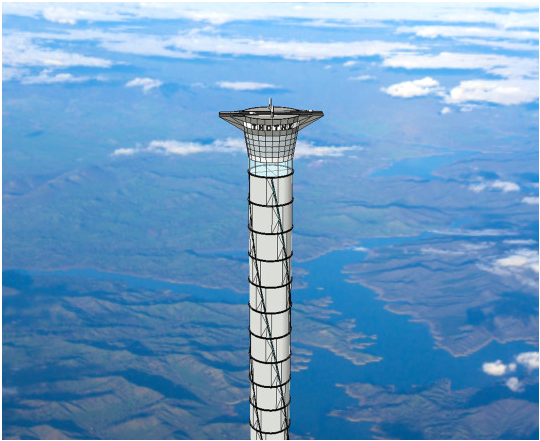Launching payloads into Earth orbit or beyond is expensive and difficult. Climbing up out of the deep gravity well of the Earth is not easy. In addition to the pull of gravity, there is also air resistance to consider. Air pressure falls off pretty rapidly above sea level. At an altitude of ten miles, the air pressure is less than ten percent of the air pressure at sea level. Obviously, if a launch vehicle can take off from a point ten miles or more above sea level, it would significantly reduce the amount of fuel required to fight gravity and air resistance. The higher you could launch, the more fuel you could save. A new company called Thoth Technology has just been granted a patent for a tower that could be used to reduce launch costs by up to thirty percent.
The basic idea is to construct a tower over twelve miles in height and seven hundred and fifty five feet in diameter. The tower would be constructed with pressurized cylindrical segments which would have a height roughly equal to their diameter. Each segment or cell in the tower would have flywheels that could act as compressors to adjust the pressure in the cell to compensate for lateral forces of winds that would otherwise cause the tower to wobble.
Astronauts would ascend the tower in a tube up the center of the tower or elevators rigged on the outside of the tower. There would be a short landing and takeoff strip on the top of the tower to permit space planes to take off and land horizontally. These space planes could launch directly into orbit without needed additional stages for boosting. They would be able to refuel and refit at the top of the tower.
Currently, the cost of launching a pound of payload into space is about ten thousand dollars. Using the Thoth Technology tower to launch may reduce launch costs to around two hundred and thirty dollars a pound.
The CEO of Thoth Technology says that the reduction in launch costs and the acceleration required would make a takeoff much more like a passenger airplane than taking off in the Space Shuttle. This would reduce the cost, danger and stress to the point where space tourism could become a realistic prospect.
The idea of using towers to reach space is an old one. Konstantin Tsiolkovsky first published the idea in 1895. He called for a free standing tower that would extend from the surface of the Earth to geosynchronous orbit at about twenty two thousand miles. Since about 1960, designs for space towers have focused on having a counterweight beyond geosynchronous orbit from which the tower would be suspended. The term in common use today is "space elevator." One of the biggest problems will be finding a material strong enough and light enough to make the space elevator. In the meantime, the Thoth Technology tower is a good place to start building towers to space.
